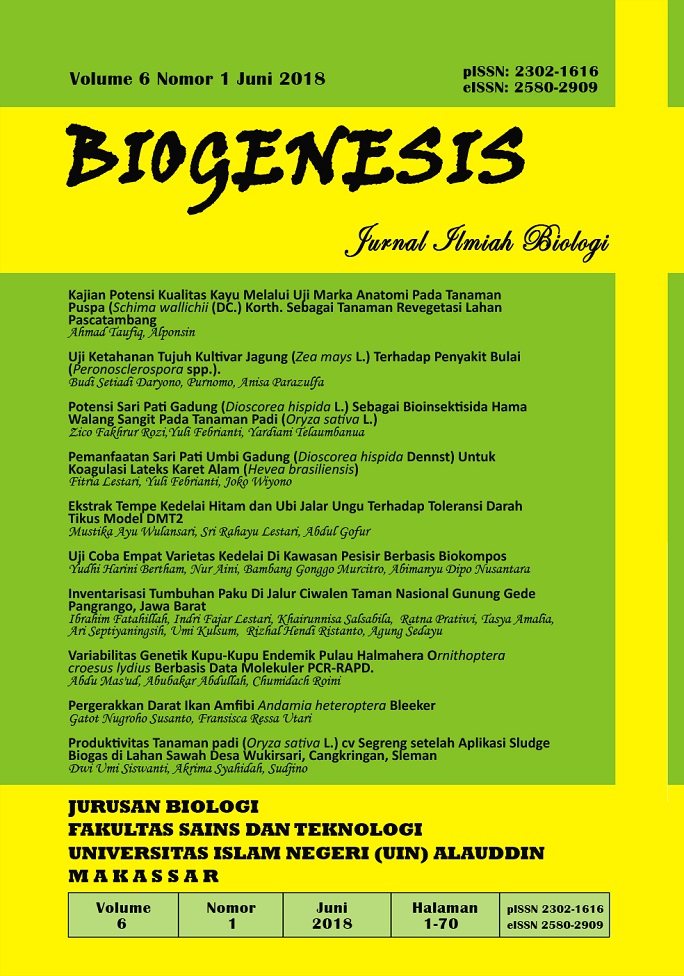Potensi Sari Pati Gadung (Dioscorea hispida L.) Sebagai Bioinsektisida Hama Walang Sangit Pada Tanaman Padi (Oryza sativa L.)
Abstract
Walang sangit (Leptocorisa acuta L.) as a rice bug is a pest that can cause a decrease in rice production (Oryza sativa L.). Excessive use of chemical pesticides will cause resistance or immunity to the pest itself. Gadung (Dioscorea hispida L.) has a compound HCN (cyanide acid) that potentially cause metabolic disturbance in insects. This study aims to determine the extract of gadung tuber effect as bioinsecticide of rice bug against rice. This research was conducted in Biology Laboratory of STKIP PGRI Lubuklinggau South Sumatera Province, with 5 treatment groups and 5 replications. The research design used was complete randomized design (RAL) with P0 control (-) without giving of starch bulb, P1 20 gr / l, P2 40 gr / l, P3 60 gr / l, P4 80 gr / l. Based on the results of analysis with Anava One Path test obtained results Fcount = 7.72 with Ftable = 4.43. It shows there is a significant influence of the extract of gadung tuber as bioinsecticide of rice bug against rice plant.References
Afifah F, Rahayu YS, Faizah U. 2015. Efektivitas Kombinasi Filtrat Daun Tembakau (Nicotiana tabacum) dan Filtrat Daun Paitan (Thitonia diversifolia) sebagai Pestisida Nabati Hama Walang Sangit (Leptocorisa oratorius) pada Tanaman Padi. Lentera Bio. vol 4(1): 25-31.
Aziz IR. 2014. Kemampuan Tumbuh Pseudomonas Putida Strain 071 Pada Medium Diazinon. Jurnal Teknosains. vol 8(1): 87-94.
Bhadauria NS and Singh P. 2009. Assessment of losses in paddy caused Leptocorisa varicornis. Annals of Plant Protection Sciences. vol 17(1): 231.
Bhandari MR and Kawabata J. 2005. Bitterness and Toxicity in Wild Yam (Dioscorea spp.) Tubers of Nepal. Plant Foods for Human Nutrition. vol 60: 129-135. https://doi.org/10.1007/s11130-005-6841-1.
Butarbutar R, Tobing MC, Tarigan MU. 2013. Pengaruh Beberapa Jenis Pestisida Nabati Untuk Mengendalikan Ulat Grayak Spodoptera litura F. (Lepidoptera: Noctuidae) Pada Tanaman Tembakau Deli di Lapangan. Jurnal Online Agroekoteknologi. vol 1(4): 1484-1494.
Chandler D, Bailey AS, Tatchell GM, Davidson G, Greaves J, Grant WP. 2011. The development, regulation and use of biopesticides for integrated pest management. Phil. Trans. R. Soc. B. vol 366: 1987-1998. https://doi.org/10.1098/rstb.2010.0390
Djaafar Tf, Rahayu S, Gardjito M. 2009. Pengaruh Blanching dan Waktu Perendaman Dalam Larutan Kapur Terhadap Kandungan Racun Pada Umbi dan Ceriping Gadung. Penelitian Pertanian Tanaman Pangan. vol 28(3): 192-198.
Hanafiah KA. 2016. Rancangan Percobaan Teori dan Aplikasi. Jakarta: PT Raja Grafindo Persada.
Mutiara D dan Novalia N. 2010. Uji Toksisitas Akut Ekstrak Umbi Gadung (Dioscorea hispida Dennst) Terhadap Kematian Larva Spodoptera litura F. Sainmatika. vol 7(2): 26-32.
Pracaya dan Kahono PC. 2011. Kiat Sukses Budidaya Padi. Singkawang: PT. Macanan Jaya Cemerlang.
Saleha S, Saidi N, Saiful, Murniana, Rasnovi S, Iqbalsyah TM. 2018. Nutritional Composition of Dioscorea Hispida from Different Locations around Leuser Ecosystem Area. Jurnal Natural. vol 18(1): 1-6. https://doi.org/10.24815/jn.v18i1.8504.
Setiawati W. 2008. Tumbuhan Bahan Pestisida Nabati dan Cara Pembuatannya Untuk Mengendalikan Organisme Pengganggu Tanaman (OPT). Bandung: Balai Penelitian Tanaman Sayuran.
Tiwari GN, Prasad CS, Nath L. 2011. Arthropod Diversity in Brinjal Ecosystem and its Relation with Weather Factors in Western Uttar Pradesh. Trends in Biosciences. vol 4(1): 12-18.
Wilson C and Tisdell C. 2001. Why farmers continue to use pesticides despite environmental, health and sustainability costs. Ecological Economics. vol 39(3): 449-462. https://doi.org/10.1016/S0921-8009(01)00238-5.
Copyright (c) 2018 Zico Fakhrur Rozi, Yuli Febrianti, Yardiani Telaumbanua

This work is licensed under a Creative Commons Attribution 4.0 International License.
COPYRIGHT AND LICENSE STATEMENT
COPYRIGHT
Biogenesis: Jurnal Ilmiah Biologi is published under the terms of the Creative Commons Attribution license. Authors hold the copyright and retain publishing rights without restriction to their work. Users may read, download, copy, distribute, and print the work in any medium, provided the original work is properly cited.
LICENSE TO PUBLISH
1. License
The use of the article will be governed by the Creative Commons Attribution license as currently displayed on http://creativecommons.org/licenses/by/4.0.
2. Author’s Warranties
The author warrants that the article is original, written by stated author/s, has not been published before, contains no unlawful statements, does not infringe the rights of others, is subject to copyright that is vested exclusively in the author and free of any third party rights, and that any necessary written permissions to quote from other sources have been obtained by the author(s).
3. User Rights
Under the Creative Commons Attribution license, the users are free to download, reuse, reprint, modify, distribute and/or copy the content for any purpose, even commercially, as long as the original authors and source are cited. No permission is required from the authors or the publishers.
4. Co-Authorship
If the article was prepared jointly with other authors, the corresponding author warrants that he/she has been authorized by all co-authors, and agrees to inform his/her co-authors of the terms of this statement.
5. Miscellaneous
Biogenesis: Jurnal Ilmiah Biologi may conform the article to a style of punctuation, spelling, capitalization, and usage that it deems appropriate. The author acknowledges that the article may be published so that it will be publicly accessible and such access will be free of charge for the readers.


